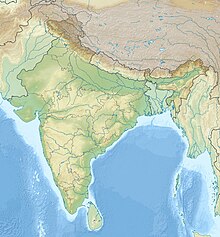| Kalaroos Caves | |
|---|---|
| Qil-e-Roos | |
 Seven openings of the Kalaroos Caves Seven openings of the Kalaroos Caves | |
  | |
| Location | Kalarooch, Jammu and Kashmir, India |
| Coordinates | 34°34′29.01″N 74°20′33.22″E / 34.5747250°N 74.3425611°E / 34.5747250; 74.3425611 |
| Elevation | 1,900 metres (6,200 ft) |
| Discovery | Ancient |
| Entrances | 7 |
| Hazards | Narrow passages, loose rocks |
| Features | Rock carvings, legends of underground passages to the neighbouring countries |
The Kalaroos Caves, also known as Qil-e-Roos (lit. 'Russian Fort'), are an ancient network of caves located in the Kupwara district of Jammu and Kashmir, India. The site has been the subject of various unverified claims, largely due to the belief that the caves connect the Kashmir Valley with Russia (or Rous). Local legends suggest that the caves may contain secret tunnels leading to the neighbouring countries; however, these assertions remain unverified, and no archaeological research has been conducted to substantiate them. The site is situated at an elevation of approx. 1,900 metres (6,200 ft) above sea level.
Background
The caves are centered around a prominent rock structure known as "satbaran", which features seven carved openings referred to as sath barr (lit. 'seven doors'). Local legends, citing ancestral accounts, associate these openings with seven different routes, including a supposed underground passage which was used by Russians, as well as six other routes leading to different countries.
Located a few meters from the satbaran rock are additional caves, one of which is tramkhan, a cave with crimson-colored walls, believed to have once served as a copper mine. It contains a weathered inscription in an unidentified foreign script. Local folklore also suggests that the caves conceal hidden water bodies, though these claims remain unverified.
During the early years of the Kashmir insurgency, the Indian Army used explosives and caused damage to the site, citing the presence of militant hideouts. In Kalarooch village, where the caves are located, a graveyard is said to contain the remains of around 300 people, including dozens of militants.
Caves
Cave 1 – It is located beyond the satbaran rock at an approximate elevation of 1,980 metres (6,500 ft). The cave begins with a narrow, upward-sloping passage extending for about 50 meters, which narrows further in certain sections. This passage leads to a 15-meter vertical shaft, opening into a small chamber. From this chamber, a 10-meter shaft descends into another room. Beyond this point, a 5-meter upward passage connects to a narrow, horizontal corridor that terminates within 15 meters. Explorations of all side passages and openings near the entrance suggested no further extensions, as each lead quickly reached a dead end.
Cave 2 – It is situated at a higher elevation of approximately 2,020 metres (6,630 ft) on the mountainside. It features the largest entrance among the three caves in the area. The primary passage slopes downward and extends for about 50 meters before ending abruptly. The cave appears to have been partially filled over time, possibly due to a landslide or natural erosion.
Cave 3 – It is located at the highest elevation of 2,260 metres (7,410 ft) on the mountain, cave 3 features a 40-meter downward-sloping passage that leads into a narrow, horizontal corridor, which ends after 20 meters. All side passages off the main corridor were partially explored, but each terminated shortly after. Local accounts suggest that the Indian Army attempted to seal the cave using explosives. This was reportedly done due to the presence of either bears or militants.
Beliefs
Local legend suggests that the caves were constructed several hundred years ago by Russian traders. Over time, the caves have been the subject of various myths, particularly regarding their alleged connection between the Kashmir Valley and Russia. These legends, passed down through generations by village elders, have become a part of the local folklore.
Although the caves have been the subject of numerous unverified claims and speculation, experts, whose identities remain unknown, suggest that Kashmir has a history of trade relations with Russia and the former Soviet Union. They also suggest that the valley and Russia share cultural and linguistic similarities, which have contributed to the continued speculation and legends surrounding the caves. The caves are also claimed to have served as sanctuaries where people sought refuge and prayed for salvation.
Local legends holds that during the era of the Silk Route, these caves were used as a passageway when the Kashmir Valley was heavily snowbound.
Exploration
No one knows the history behind the structure, who built it, or its age.
— Amber and Eric Fies
In 2018, American explorers Amber and Eric Fies visited the Kalaroos caves to investigate claims of secret underground passages. They surveyed three caves and documented their findings. They speculated that two of the caves might have been interconnected at some point in the past, with one inclining upwards and the other sloping downwards, sharing similar elevations and orientations.
The third cave, however, could not be fully examined as it had been sealed by the Indian Army. Amber and Eric Fies also suggested that its origin, construction, and age remain unknown. While no evidence of recent human activity was found inside the sealed cave, traces of Himalayan porcupines were observed.
References
- ^ Pal, Suchismita (2020-04-29). "These Caves In Kashmir Could Possibly Be Secret Tunnels To Russia". Curly Tales. Retrieved 2025-01-06.
- ^ Hussain, Masood (2018-11-17). "American Explorers Get Into Kalaroos Caves, Explode Generational Myths". Kashmir Life. Retrieved 2025-01-06.
- "At LoC tourism site in Kashmir, two ancient sites bore signs of violence". Hindustan Times. 2012-10-01. Retrieved 2025-01-06.
- ^ Qayoom, Aatif (2023-06-25). "The Legend of Kalaroos Caves;A JOURNEY THROUGH NATURE, MYTH, HISTORY". Rising Kashmir. Retrieved 2025-01-06.
- "The Mysterious Caves of Kalaroos". Kashmir Reader. 2020-10-26. Retrieved 2025-01-06.